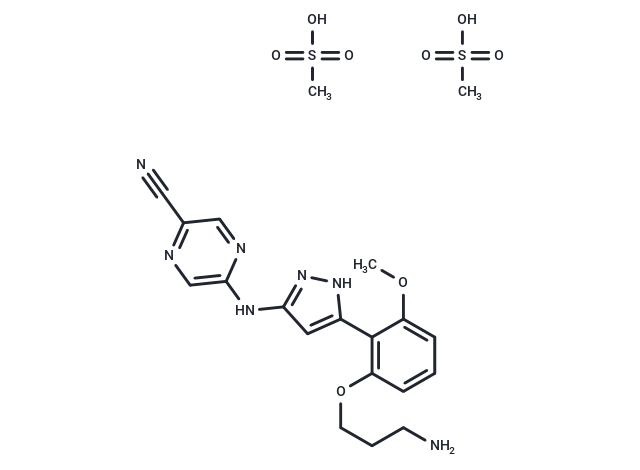Shopping Cart
Remove All Your shopping cart is currently empty
Your shopping cart is currently empty
Prexasertib dimesylate (LY2606368 dimesylate) is a highly selective, ATP-competitive, second-generation inhibitor of checkpoint kinase 1 (CHK1), with a K_i of 0.9 nM and an IC_50 of <1 nM, and also effectively inhibits CHK2 (IC_50 = 8 nM) and RSK1 (IC_50 = 9 nM). Its mechanism induces double-stranded DNA breakage and replication catastrophe, leading to apoptosis, and demonstrates potent anti-tumor activity.

| Pack Size | Price | USA Warehouse | Global Warehouse | Quantity |
|---|---|---|---|---|
| 2 mg | $52 | 5 days | 5 days |
| Description | Prexasertib dimesylate (LY2606368 dimesylate) is a highly selective, ATP-competitive, second-generation inhibitor of checkpoint kinase 1 (CHK1), with a K_i of 0.9 nM and an IC_50 of <1 nM, and also effectively inhibits CHK2 (IC_50 = 8 nM) and RSK1 (IC_50 = 9 nM). Its mechanism induces double-stranded DNA breakage and replication catastrophe, leading to apoptosis, and demonstrates potent anti-tumor activity. |
| Targets&IC50 | Chk1:<1 nM (IC50), Chk1:0.9 nM (Ki), Chk2:8 nM (IC50) |
| In vitro | Prexasertib dimesylate (LY2606368 dimesylate) demonstrates significant inhibitory activity against various kinases, including MELK (IC 50 =38 nM), SIK (IC 50 =42 nM), BRSK2 (IC 50 =48 nM), and ARK5 (IC 50 =64 nM), by targeting mechanisms crucial for cell cycle progression and mitosis. It relies on CDC25A and CDK2 to induce DNA damage. Specifically, treatment with 33 and 100 nM concentrations for 7 hours causes DNA damage during the S-phase in HeLa cells, while pretreatment at concentrations ranging from 8-250 nM for 15 minutes inhibits CHK1 (S296) and CHK2 (S516) autophosphorylation in HT-29 cells. At a lower concentration of 4 nM over 24 hours, it induces a substantial cell cycle shift from G1 and G2-M to S-phase, accompanied by an increase in H2AX phosphorylation in U-2 OS cells. A concentration of 33 nM for 12 hours leads to chromosomal fragmentation in HeLa cells, and at 100 nM from 0.5 to 9 hours, it triggers replication stress and reduces the availability of RPA2 for DNA binding. Cell cycle analysis and Western blot analyses further confirm its impact, revealing DNA damage in the G2-M population and inhibition of CHK1 and CHK2 autophosphorylation at concentrations as low as 31 nM in HeLa and HT-29 cells respectively. |
| In vivo | Prexasertib dimesylate (LY2606368 dimesylate), administered subcutaneously (SC) at dosages of 1-10 mg/kg twice daily for three cycles (each comprising 3 days of treatment followed by 4 days of rest), demonstrated significant inhibition of tumor growth in xenograft models[1]. At a higher dosage of 15 mg/kg, administered SC, this compound effectively inhibited CHK1 in the blood and induced phosphorylation of H2AX (S139) and RPA2 (S4/S8), indicating rapid DNA damage[1]. These studies were conducted using female CD-1 nu-/nu- mice (26-28 g) implanted with Calu-6 cells. For the tumor growth inhibition study, dosages of 1, 3.3, or 10 mg/kg resulted in up to 72.3% reduction in tumor size. In pharmacokinetic analysis at 15 mg/kg, CHK1 levels in plasma were 7 ng/mL at 12 hours, decreasing to 3 ng/mL by 24 hours, with detectable phosphorylation of H2AX and RPA2 as early as 4 hours post-administration, demonstrating the compound's swift action in causing DNA damage. |
| Synonyms | LY2606368 dimesylate |
| Molecular Weight | 557.6 |
| Formula | C20H27N7O8S2 |
| Cas No. | 1234015-58-7 |
| Smiles | CS(O)(=O)=O.CS(O)(=O)=O.COc1cccc(OCCCN)c1-c1cc(Nc2cnc(cn2)C#N)n[nH]1 |
| Storage | Powder: -20°C for 3 years | In solvent: -80°C for 1 year | Shipping with blue ice/Shipping at ambient temperature. |
| Size | Quantity | Unit Price | Amount | Operation |
|---|

Copyright © 2015-2026 TargetMol Chemicals Inc. All Rights Reserved.